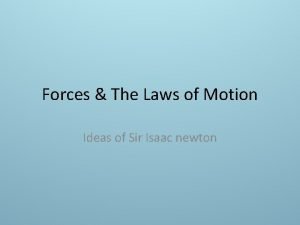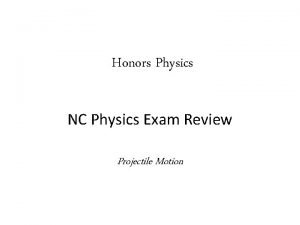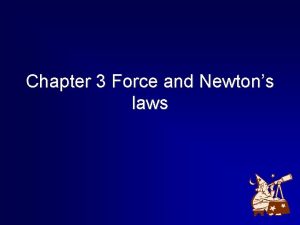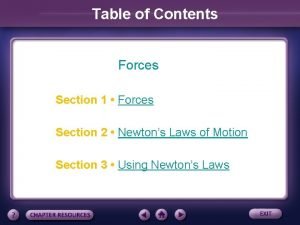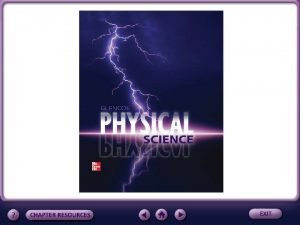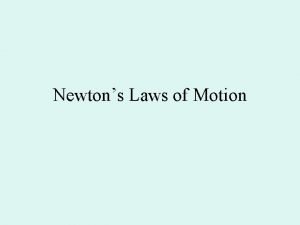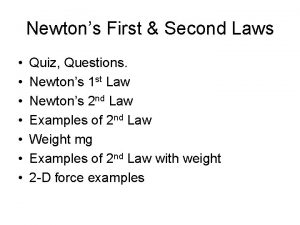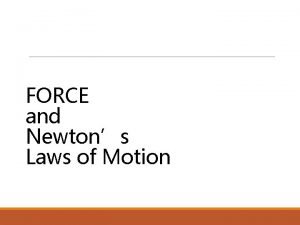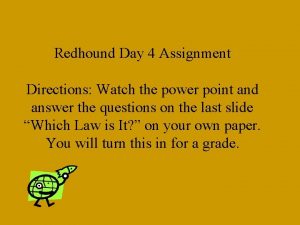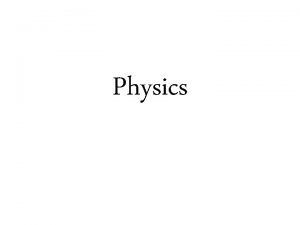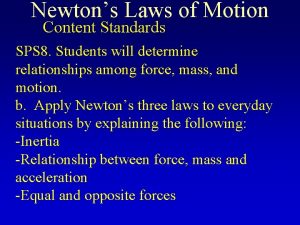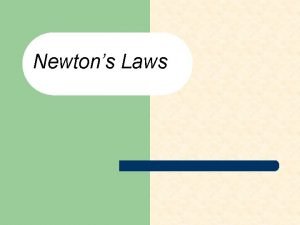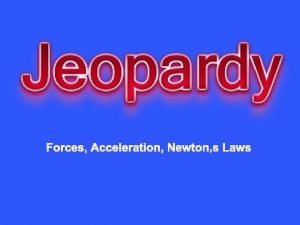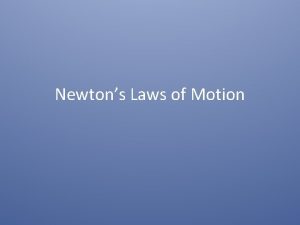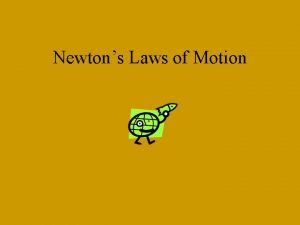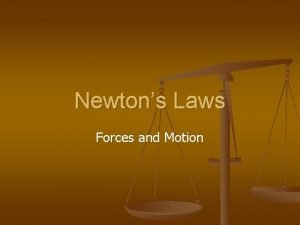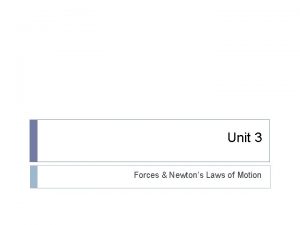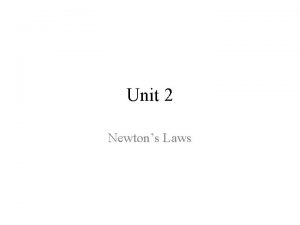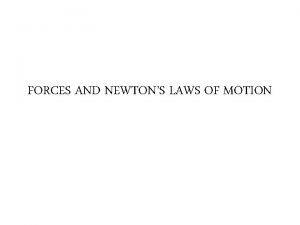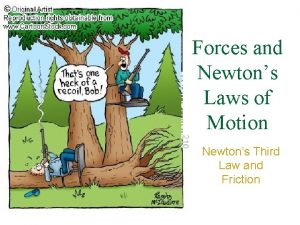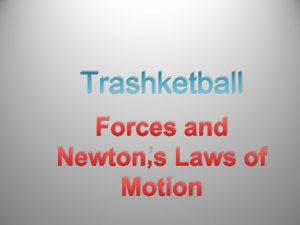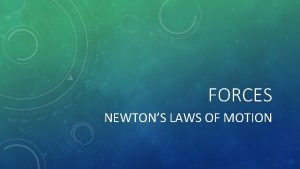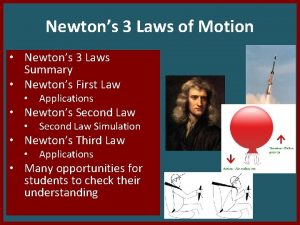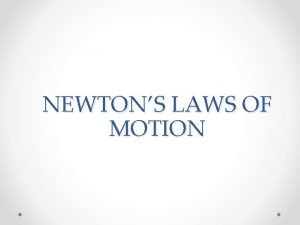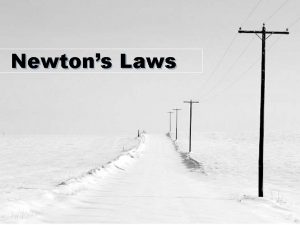UNIT 3 Forces Newtons Laws of Motion HONORS




















- Slides: 20

UNIT 3 Forces & Newton’s Laws of Motion

HONORS – TUESDAY 11/19 Upcoming: • Physics Fun Fact! – Scott Kelly Newton’s Law Video Newton’s Law Quiz • Pass back Unit 2 Test (Fri/Mon) • (absent? Take it now!) Newton’s 2 nd Law Lab Friction Lab • Newton’s Law Video After Break: Toothpick Bridge Project • Groups of 3 Physics Fun Fact • Research Newton’s Laws of Motion. Create a video Presentations teaching each law with a visual demonstration for each.

CONCEPTUAL – TUESDAY 11/19 • Physics Fun Fact! – Scott Kelly • Pass back Unit 2 Test • (absent? Take it now!) • Newton’s Law Video • Groups of 3 Upcoming: Newton’s Law Video Newton’s Law Quiz (Fri/Mon) Friction Lab After Break: Toothpick Bridge Project Physics Fun Fact Presentations • Research Newton’s Laws of Motion. Create a video teaching each law with a visual demonstration for each.

HONORS – THURSDAY 11/21 • Physics Fun Fact! – Scott Kelly • Discuss Newton’s Laws • Types of Forces • Weight vs. Mass • Complete 2 nd Law Lab • Newton’s Law Quiz Next Class Upcoming: Newton’s Law Quiz (Next Class) Free Body Diagram Homework After Break: Free Body Diagram Quiz (12/3 & 12/4) Friction Lab Toothpick Bridge Project Physics Fun Fact Presentations

CONCEPTUAL – THURSDAY 11/21 • Physics Fun Fact! – Scott • Discuss Newton’s Laws • 2 nd Law Lab discussion • Free Body Diagrams • Station introduction Upcoming: Newton’s Law Quiz (Next Class) Kelly Free Body Diagram Homework (due next class) After Break: Free Body Diagram Quiz (12/3 & 12/4) Friction Lab Toothpick Bridge Project Physics Fun Fact Presentations • Formative. (1 st page homework due fri/mon) • Newton’s Law Quiz Next Class

HONORS – FRIDAY 11/22 • Newton’s Laws Quiz • Physics Fun Fact! – Scott Kelly • Free Body Diagrams • 2 nd Law Lab Recap • #4 on Warm Up • FBD Homework (all pages) Upcoming: Free Body Diagram Homework After Break: Free Body Diagram Quiz (12/3 & 12/4) Friction Lab Toothpick Bridge Project Physics Fun Fact Presentations

CONCEPTUAL – FRIDAY 11/22 • Physics Fun Fact! – Scott Kelly • Newton’s Laws Quiz • Continue Free Body Diagrams • Complete Worksheet 2 • Balanced Forces/Equilibrium Upcoming: Free Body Diagram Homework After Break: Free Body Diagram Quiz (12/3 & 12/4) Friction Lab Toothpick Bridge Project Physics Fun Fact Presentations

SIR ISAAC NEWTON • 1643 – 1727 England • Described as a Natural Philosopher • Mathematician, Physicist, Author, Astronomer. • Created Calculus • Founded the Laws of Motion & Law of Universal Gravitation. • https: //www. youtube. com/watch? v=D 6_UVBAfd. HA

FORCE • A force is a push or pull acting upon an object as a result of its interaction with another object. There a variety of types of forces. Force is a Vector quantity. • Measured in Newtons [N] • Types of Forces: • Frictional Force • Tension Force • Normal Force • Air Resistance Force • Gravitational Force • Magnetic Force • Etc.

FRICTION • Friction is the resistance to motion of one moving object relative to another. • Types of Friction: Static Friction – Force that keeps an object at rest. Must be overcome to move an object Kinetic Friction: • Sliding Friction – Force that resists the movement of a sliding object • Rolling Friction – Force that resists the movement of a rolling object • Liquid Friction – Force that resists the movement of an object through a liquid

NEWTON’S LAWS OF MOTION • First Law – An object in motion or at rest will remain in motion or at rest until acted on by an outside force • Second Law – F = ma • Third Law – For every action, there is an equal but opposite reaction

WEIGHT VS. MASS • Mass – Amount of matter an object contains. Doesn’t change. • Weight – The pull of gravity on an object. Weight is a Force. W = mg Unit: 2 [N] Gravity on Earth = 9. 8 m/s Gravity on the Moon = 1. 62 m/s 2 To convert your Weight (N) to Weight (lbs) you can convert using the method to the left.

INERTIA • The tendency to do nothing or to remain unchanged • Represented by Newton’s 1 st Law of Motion • Mass directly effects an object’s Inertia • https: //www. youtube. com/watch? v =7 COUk 5 eh 6 j. Y

FREE BODY DIAGRAMS • Also known as Force Diagrams • A universal way of notating and communicating Forces acting on an object. • Net Force (Sum of Forces) – A numerical combination of all forces acting on an object.

BALANCED & UNBALANCED FORCES • Balanced forces – Will NOT move an object • Normal Force – Book sitting on a desk • 2 students applying equal forces to opposite sides of a box • Unbalanced forces – Will move an object • 1 student pushing a box, accelerating it • A ball falling through air

ATWOOD MACHINE • Invented by Mathematician George Atwood in 1784 as a laboratory experiment to verify mechanical laws of motion with a constant acceleration. • Created after Newton’s laws of motion • When solving an Atwood Machine problem, ALWAYS begin with an analysis of Sum of Forces.

FRICTION LAB Part 1 Part 2 • Measure Static & Kinetic Frictions • Add 0. 5 kg (Total mass = 1 kg) • Use different surface areas • Measure Static & Kinetic Frictions on wide side only • 500 g (0. 5 kg) Part 3 Part 4 • Add 0. 5 kg (Total mass = 1. 5 kg) • Using 3 different surfaces, observe friction at different angles. • Measure Kinetic Friction at different speeds • USE CARDBOARD AS INSTRUCTED!!

BRIDGE PROJECT • Groups of 3 students • Materials: • 1 sheet wax paper • 100 toothpicks • Elmer's Glue Thur sday Test 12/6 Bridg es & Sum m b egin a t i (Lap ve w top C rite u p arts in cla ss) • Must hold 1 textbook (each extra will be a bonus) • Testing distance: 10 Inches • Toy car must be able to drive through


 Colin skateboards down the sidewalk
Colin skateboards down the sidewalk Newtons first lw
Newtons first lw Newton three law of motion
Newton three law of motion Law of newton 3
Law of newton 3 Derek leaves his physics book on top of a drafting table
Derek leaves his physics book on top of a drafting table Vyi physics
Vyi physics Newton's law
Newton's law Newton's laws of universal gravitation
Newton's laws of universal gravitation Newtons 3 rd law of motion
Newtons 3 rd law of motion Third law of newton
Third law of newton Section 3 using newton's laws
Section 3 using newton's laws Section 1 forces
Section 1 forces Elevator bank
Elevator bank Newtons 1 st law
Newtons 1 st law Newton's first and second law quiz
Newton's first and second law quiz Newton's 3rd law example
Newton's 3rd law example What are newtons three laws
What are newtons three laws Law of acceleration
Law of acceleration Law of newton
Law of newton Newton's first law of motion examples
Newton's first law of motion examples Newtons laws
Newtons laws




